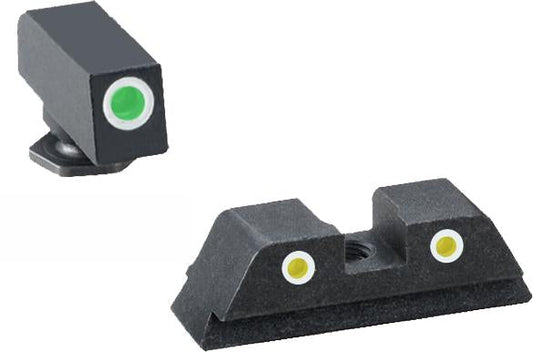

Ameriglo Classic Tritium Night Sight Set enhances your GLOCK with reliable performance under various lighting conditions. Featuring vibrant green tritium lamps and white outlines, this sight set ensures you maintain clear visibility, whether during the day or in low-light scenarios. Designed specifically for GLOCK models like the 17, 19, 22, and 26, it allows for precise aiming, ensuring you hit your target every time. The tall set option is particularly useful if you're mounting a suppressor or optic, providing versatility for tactical setups.
Stability during intense shooting sessions is guaranteed with the rear sight's set screw feature. This allows for quick adjustments while maintaining security, giving you the confidence to focus on your aim. The Ameriglo Classic Tritium Night Sight Set is a practical upgrade for any GLOCK owner seeking to improve accuracy and performance.
Features:
- ENHANCED VISIBILITY for all lighting conditions with bright green tritium lamps.
- HEAVY-DUTY DESIGN ensures durability and longevity, perfect for rugged use.
- COMPATIBLE FIT with various GLOCK models, including 17, 19, and 26, for versatile use.
- TALL SET OPTION available for suppressor or optic use, ideal for tactical setups.
- QUICK INSTALLATION with set screw rear sights for secure and easy adjustments.
- ACCURATE AIM with a 140" wide front and 150" notch for precise targeting.
- WHITE OUTLINE enhances focus on the front sight for quicker target acquisition.
- RELIABLE PERFORMANCE under any conditions ensures you hit your target every time.
Technical Specifications Table
| Feature | Details |
|---|---|
| Compatibility | GLOCK 17, 19, 22, 23, 24, 26, 27, 33, 34, 35, 37, 38, 39 |
| Type | 3-Dot Tritium Night Sight Set |
| Material | High-quality metal and tritium |
| Front Width | 140" |
| Rear Notch Width | 150" |
| Color | Green tritium with white outline |
What’s in the Box?
- A pair of front and rear night sights
- Installation tool
- User manual
Customer Reviews
"These night sights are a game changer! Perfect for low-light conditions." - John D.
"Installation was a breeze, and the visibility is outstanding!" - Mark T.
FAQ
How do I maintain the Ameriglo Tritium Night Sights?
To maintain your sights, regularly check for any debris or dirt and clean them with a soft cloth. Avoid abrasive cleaners to prevent scratching the lenses.
How do these compare with other sights?
The Ameriglo Tritium sights stand out with their bright tritium illumination and robust construction, making them superior for low-light situations compared to traditional sights.
Similar Models
If you're exploring options, check out our additional Ameriglo night sights designed for various firearm models. Discover superior visibility and unmatched performance. Explore our full collection for exceptional optics tailored to your shooting needs.
You May Also Like
Here’s some of our most similar products people are buying. Click to discover trending style.






